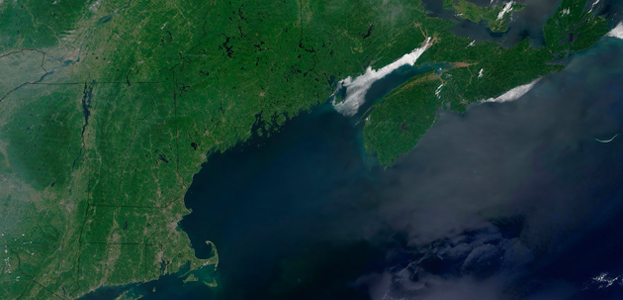
NASA, UMaine Endeavor to Better Understand Phytoplankton, Carbon Cycling
University of Maine oceanographer Ivona Cetinic is participating in a NASA project to advance space-based capabilities for monitoring microscopic plants that form the base of the marine food chain.
Phytoplankton — tiny ocean plants that absorb carbon dioxide and deliver oxygen to Earth’s atmosphere — are key to the planet’s health. And NASA wants a clear, global view of them.
NASA’s Ship-Aircraft Bio-Optical Research (SABOR) mission will bring together marine and atmospheric scientists to tackle optical issues associated with satellite observations of phytoplankton.
The goal is to better understand marine ecology and phytoplankton’s major role in the global cycling of atmospheric carbon between the ocean and the atmosphere.
“Teams involved in this project are working together to develop next-generation tools that will change forever how we study oceans,” says Cetinic, a research associate at UMaine’s Darling Marine Center (DMC) in Walpole, Maine.
“Methods that will be developed during this experiment are something like 3-D glasses. They will allow us to see more details on the surface of the ocean and to see deeper into the ocean, helping us learn more about carbon in the ocean — carbon that is fueling oceanic ecosystems, as well as the fisheries and aquaculture.”
Cetinic will be a chief scientist aboard RV Endeavor that departs July 18 from Narragansett, Rhode Island. She received $1,043,662 from NASA’s Ocean Biology and Biogeochemistry program for her part in the three-year project.
Cetinic’s crew, which includes Wayne Slade of Sequoia Scientific, Inc., Nicole Poulton of Bigelow Laboratory for Ocean Sciences and UMaine Ph.D. student Alison Chase, will analyze water samples for carbon, as well as pump seawater continuously through on-board instruments to measure how ocean particles, including phytoplankton, interact with light.
Chase, who recently earned her master’s in oceanography at UMaine, will blog about the experience at earthobservatory.nasa.gov/blogs/fromthefield.
Interim DMC director Mary Jane Perry, who is participating in another research cruise this summer (umaine.edu/news/blog/2014/07/08/under-the-ice), will be involved in future data analysis.
Mike Behrenfeld of Oregon State University also will be aboard Endeavor and he and his team will use a new technique to directly measure phytoplankton biomass and photosynthesis.
“The goal is to develop mathematical relationships that allow scientists to calculate the biomass of the phytoplankton from optical signals measured from space, and thus to be able to monitor how ocean phytoplankton change from year to year and figure out what causes these changes,” he says.
Another research team also will be aboard Endeavor, which for three weeks will cruise through a range of ecosystems between the East Coast and Bahamas.
Alex Gilerson of City College of New York will lead a crew that will operate an array of instruments, including an underwater video camera equipped with polarization vision. It will continuously measure key characteristics of the sky and the water.
The measurements taken from aboard the ship will provide an up-close perspective and validate measurements taken simultaneously by scientists in aircraft.
NASA’s UC-12 airborne laboratory, based at NASA’s Langley Research Center in Hampton, Virginia, will make coordinated science flights beginning July 20.
One obstacle in observing marine ecosystems from space is that atmospheric particles interfere with measurements. Brian Cairns of NASA’s Goddard Institute for Space Studies in New York will lead an aircraft team with a polarimeter instrument to address the issue.
From an altitude of about 30,000 feet, the instrument will measure properties of reflected light, including brightness and magnitude of polarization. These measurements will define the concentration, size, shape and composition of particles in the atmosphere.
Polarimeter measurements of reflected light should provide valuable context for data from another instrument on the UC-12 designed to reveal how plankton and optical properties vary with water depth.
Chris Hostetler of Langley is leading that group. He and others will test a prototype lidar (light detection and ranging) system — the High Spectral Resolution Lidar-1 (HSRL-1). A laser that will probe the ocean to a depth of about 160 feet should reveal how phytoplankton concentrations change with depth, along with the amount of light available for photosynthesis.
Phytoplankton largely drive the functioning of ocean ecosystems and knowledge of their vertical distribution is needed to understand their productivity. This knowledge will allow NASA scientists to improve satellite-based estimates of how much atmospheric carbon dioxide is absorbed by the ocean.
NASA satellites contributing to SABOR are the Cloud-Aerosol Lidar and Infrared Pathfinder Satellite Observation (CALIPSO), which view clouds and tiny particles in Earth’s atmosphere, as well as the Terra and Aqua satellites, which measure atmospheric, land and marine processes.
Analysis of data collected from the ship, aircraft and satellites is expected to guide preparation for a new, advanced ocean satellite mission — Pre-Aerosol, Clouds, and ocean Ecosystem (PACE), according to NASA.
PACE will extend observations of ocean ecology, biogeochemical cycling and ocean productivity begun by NASA in the late 1970s with the Coastal Zone Color Scanner and continued with the Sea-viewing Wide Field-of-view-Sensor (SeaWiFS) and the Moderate Resolution Imaging Spectroradiometer (MODIS) instruments on Terra and Aqua.
SABOR is funded by the Earth Science Division in the Science Mission Directorate at NASA Headquarters.
Contact: Beth Staples, 207.581.3777
